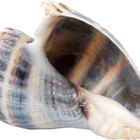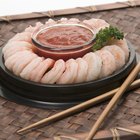
For many Americans, squid is most familiar in the form of breaded rings, served golden brown as an appetizer at restaurants and bars. Graduating from a casual acquaintance with calamari rings to a hands-on familiarity with fresh squid takes practice, but the cephalopods are surprisingly easy to clean and cook. Their internal organs are usually discarded, though they are a delicacy in some cultures, and the ink sac has some well known culinary uses.
Basics of Squid
Squid are part of a family called cephalopods, a name derived from the Greek words for foot and head. Like their cousins octopus and cuttlefish, they consist of an elongated head and body connected to a cluster of tentacles which can act as arms or legs as needed. Their anatomy is very simple. The main portion of their body, called the mantle, contains all the internal organs. The eyes and bird-like bill are in the middle, and tentacles account for the remainder.
Removing the Insides
This rudimentary anatomy makes cleaning a squid simple and straightforward. Grasp the middle portion, where the eyes are located, and gently but firmly pull it away from the body. Most of the internal organs will slide out with it. Cut across just below the eyes, separating the tentacles from the rest. Reach into the mantle and pull out the rigid quill -- a vestigial backbone -- and scoop out any remaining internal organs with your finger, or squeeze them out of the mantle by scraping it with the back of your knife blade.
Edible Innards
Very small baby squid are often cooked and eaten whole, just like baby eels and small finned fish. Larger squids' sexual organs and liver are sometimes eaten. The sexual organs are the oblong portion of the entrails extending furthest into the tip of the mantle, pale white in males but translucent in females unless they're filled with edible roe. The liver is pale pink, and can be found beneath the ink sac near the squid's vent. In Asia, squid is often fermented in salt and livers to make a condiment called shio kara. In Western restaurants, you're more likely to see recipes that use the squid's ink sac. It's a small, dark bladder located just above the eyes.
Using the Ink
Squid ink is often used to give a delicately briny flavor and bold, dark color to pasta or rice dishes. To add it to your fresh pasta, carefully pierce one end of the ink sac and squeeze the ink into your beaten eggs. As you mix the eggs and flour, the ink spreads throughout the dough and colors it. For risotto, add your squid ink to the hot stock your rice is cooked with. Allow approximately one tablespoon of ink per cup of uncooked rice. If you don't have enough, ink can be purchased from some fishmongers or specialty gourmet shops. It stains, so wear an apron and gloves while you're handling it.
Related Articles

Do You Have to Clean Octopus Tentacles ...
How to Cook Ladyfish

How to Devein Tiger Prawns

How to Clean Fresh Crabs to Freeze

How to Batter & Fry Calamari

Fastest Way to Clean & Freeze Catfish

Edible Parts of a Cod Fish

How to Peel & Devein Crawfish

How to Cook Apple Snail Meat

How to Remove Whelk Shells

Types of Edible Clams

How to Clean Scallops

How to Fillet a Goliath Grouper

How to Remove Membrane From Chicken ...

How to Marinate & Fry Squid

How to Remove Jibbitz on Crocs

Is it Normal for Chicken to Bleed When ...

How to Eat a Quince

What Is the Dark Line on a Boiled ...

How to Cook Salmon Cheeks
References
- On Food and Cooking: The Science and Lore of the Kitchen; Harold McGee
- BBC Good Food: How to Prepare Squid
- Fine Cooking: Squid
Resources
Writer Bio
Fred Decker is a trained chef and prolific freelance writer. In previous careers, he sold insurance and mutual funds, and was a longtime retailer. He was educated at Memorial University of Newfoundland and the Northern Alberta Institute of Technology. His articles have appeared on numerous home and garden sites including GoneOutdoors, TheNest and eHow.
Photo Credits
Eising/Photodisc/Getty Images